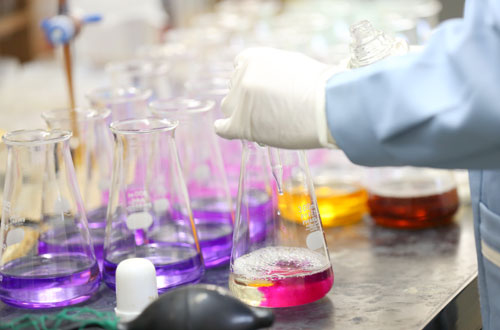Select by purpose
Select by purpose
What processes are possible for each of our customers' needs such as hardening, providing luster and darkening the color are summarized in a list.
Please feel free to ask. We will offer various different proposals.
Customer needs and possible range of processes at AKITA KAGAKU
○:Process is available at our company, △:Process is possible upon consultation, ×:We are sorry but we do not offer this process.
| What purpose? | Name of appropriate process | Process availability at our company |
Outline of plating |
|---|---|---|---|
| Hardening | Hard chromium plating | ○ | This is the hardest type among electric plating, and it excels in "abrasion resistance" and "corrosion resistance." |
| Electroless nickel | ○ | Since the plating is formed with a uniform film thickness, it is suited to "objects with complex shapes" and "objects with dimensional precision." Hv700 and higher can be provided. | |
| Hard alumite | ○ | This process adds functional properties such as corrosion protection and decoration by oxidizing the surface layer of aluminum by electrolysis. Hv300 to 500 is available. | |
| Improvement in sliding properties | Teflon electroless nickel | ○ | Plating film is uniform with good sliding properties as well as water repellency. |
| Teflon alumite | × | Delivers good sliding properties, peeling properties from other materials, and water repellency. | |
| Delustering | Chemical pearskin | ○ | The surface roughness of the base is chemically increased. It addresses finer roughness than blasting. |
| Blasting | △ | The surface roughness of the base is increased by blasting particles of iron, sand, glass and so forth in this method. There are wet and dry types. | |
| Giving luster | Electrolytic polishing | ○ | A method which addresses a smooth, glossy surface by anodic dissolution of the metal surface in a certain solution |
| Chemical polishing | ○ | A method which chemically addresses a smooth, glossy surface by soaking the metal surface in a certain solution | |
| Buffing | ○ | A method to mechanically polish the metal surface | |
| Darkening | Blackening | △ | It darkens the surface of iron and stainless steel materials in a simplified manner but it is inferior to other methods in corrosion resistance. |
| Black alumite | ○ | Used for aluminum materials. | |
| Black chromate | ○ | Used for galvanized materials. | |
| Black chromium | △ | Used for materials that need to be black and hard. | |
| Black electroless nickel | ○ | The material can be blackened with high dimensional precision. | |
| Strict observation of dimensional precision | Electroless nickel | ○ | This is a process which satisfies both dimensional precision and corrosion resistance. |
| Chemical polishing | ○ | Used for burr removal and addressing finish tolerance. |




